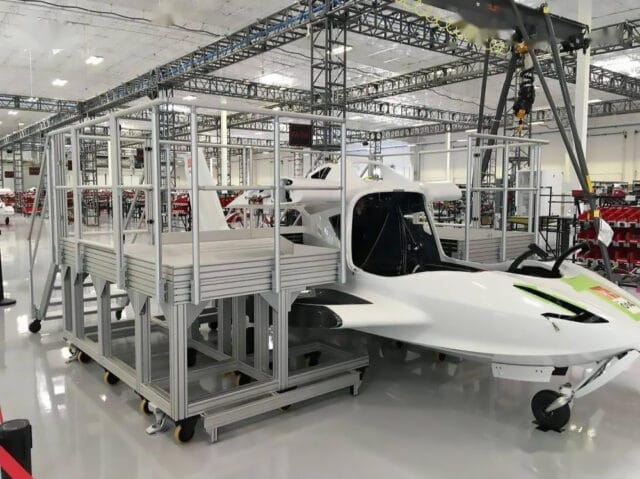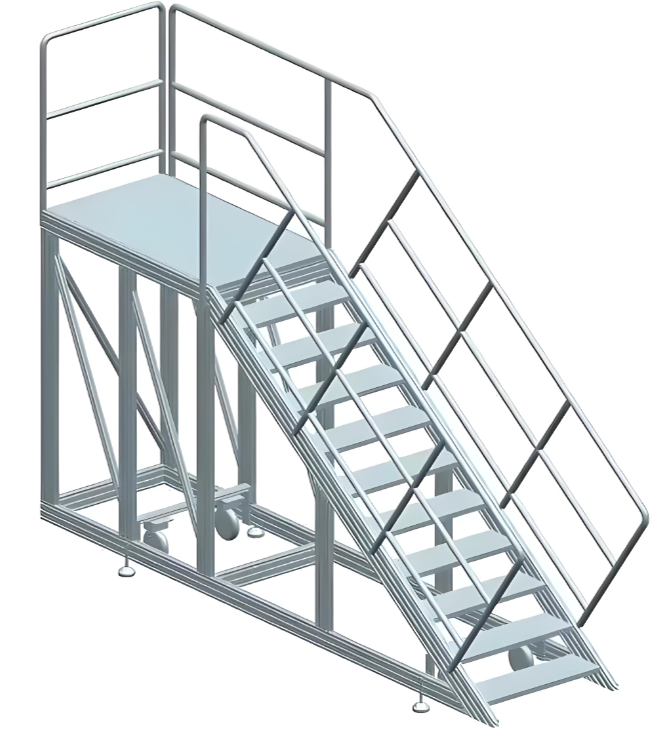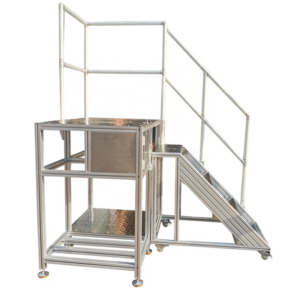Constructed from high-grade aluminum, these structures are the pinnacle of access solutions, offering unmatched durability and adaptability for various environments. They are engineered to enhance operational efficiency and safety, providing a reliable and stylish solution for all your access needs.
Descriptio
Industrial Step Ladder with Platform
Stair platforms in the industrial field must be stable enough to ensure the safety of employees and equipment; at the same time, they must be flexible enough to cope with complex and changing industrial environments.
For stairs in industrial environments, safety comes first. All indicators related to stairs, such as anti-slip performance, load-bearing capacity and stair lighting, must meet safety requirements. On the basis of safety, it must also be durable and, if possible, it should also have a beautiful appearance – so what we really need is a staircase that is “both inside and outside”.
Overview of Various Safety Standards for Stair Platforms
01 Tread edge and tread width
The tread edge refers to the dimension by which the front edge of the upper step exceeds the lower step in the tread width direction. According to the industrial staircase standard, the tread edge must be greater than or equal to 10 mm. The step height within the staircase should always remain constant.
If we can not do this, the maximum allowable reduction in the step height from the floor to the first step is 15%. Increasing the step height, people only allow in special circumstances, such as stairs leading to movable machines.
Let’s look at the tread width: the industrial staircase standard requires that the width of the auxiliary stairs for lifts and maintenance platforms must be at least 800 mm. If we only use the stairs occasionally, a width of 600 mm is permitted.
In special cases where a risk assessment has been carried out in advance, a reduction to 500 mm is permitted. If multiple people use the stairs at the same time, the width must be at least 1,000 mm.
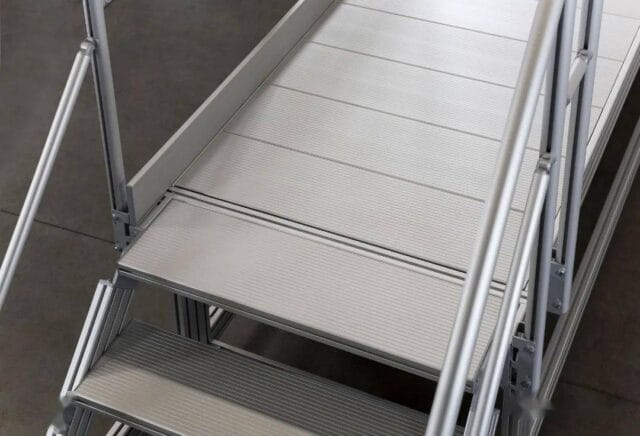
02 Ladders and Non-slip Treads
People may use ladders (in this case ordinary ladders) if the climbing angle is above 45°. tamen, we only use ladders occasionally by personnel who have been trained to do so. The climbing angle when using ladders should not be greater than 60°. The steps of the ladder must be at least 80 mm deep.
tamen, the height of a single step must not exceed 250 mm. The reference dimension of the leading edge of the tread is greater than or equal to 10 mm. The usable area between the two side rails is specified to be between 500 and 800 mm. The headroom (i.e. the vertical distance upwards) must not be less than 2,300 mm at any point.
In areas where there is a risk of slipping, the stair treads must have a non-slip surface. Even if there is no real danger, we generally recommend it to focus on such materials: safety comes first. For open-air stairs, we must take additional measures to prevent slipping due to weather conditions.
Others We Need Notice
03 Color coding and stair lighting
To be able to walk safely on stairs, the steps and especially the edge of the steps must be clearly distinguishable, otherwise it will increase the risk of falling greatly. Adequate stair lighting is therefore absolutely essential: the recommended lighting intensity is at least 150 lux at 200 mm above the step surface.
Autem, we can ensure the safety of employees by color-coding the treads and risers of the steps or by color-coding the edge of the steps.
04 Standard load-bearing capacity of industrial stairs
The load capacity of industrial stairs varies significantly depending on the supporting structure. This also takes into account the EN ISO 14122 standard described in the blog. For an unladen person walking on the stairs, at least 1.5 kN/㎡ is calculated. For one or more laden persons, 5 kN/㎡ is calculated.
We need examine each step according to the load capacity: steps with a width of up to 1,200 mm must withstand a minimum load of 1.5 kN per 100×100 mm surface. Steps with a width of 1,200 mm or more must withstand a load of 1.5 kN at multiple locations.
Based on the above standards, industrial stairs and steps generally follow the following principle: during the load test, the bending of the supporting structure and we do not allow the steps to exceed 1/300 of the span.
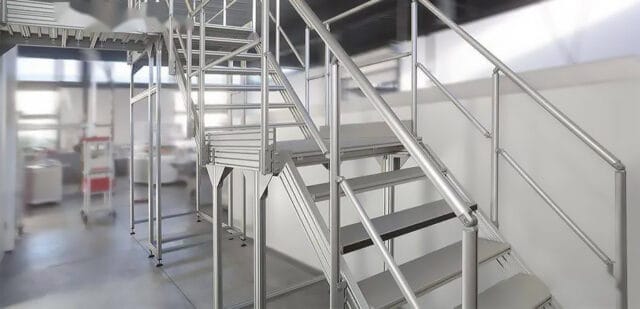
What is a Professional Stair Platform System
Ergonomic stairs
Every work task and its available space are different. So Toshine offers an option that guarantees ease of use and space saving. With four different slopes of 30°, 45° and 60°, we can modify all solutions individually and meet the most stringent safety requirements.
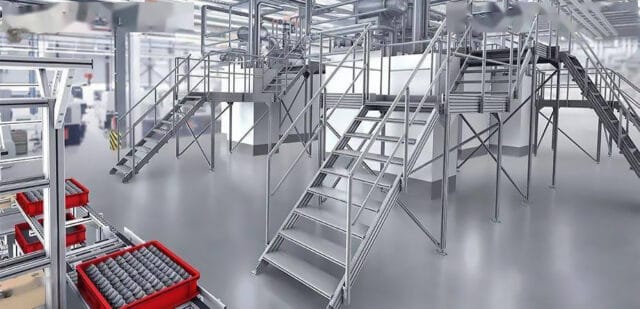
Worry-free safety guardrails
Ensuring production safety is Toshine’s top priority. Toshine comes with a technologically advanced multifunctional guardrail system, including pillars, handrails, foot guardrails and knee guardrails. At the same time, we can adjust all components according to the specific requirements of the working environment.
Stable and practical platform
We need design every structure of the stair platform according to professional concepts. It is safe, beautiful and flexible, ensuring that you will eventually provide you with a stair platform with excellent functionality and practicality.
Classic Components of the Stair Platform System
▼ Stair assembly components for fixing to the ground or the next floor
▼ Tread profiles with high-precision anti-slip bumps on the surface
▼ Pillar angle fasteners for connecting handrails at any angle
How to Choose the Slope of the Stairs
▍Ramp or stairs? The key is the angle
The international standard DIN EN ISO 14122 sets some requirements for the problem of setting up permanent access to equipment that cannot be directly approached from the ground or at the same height. “Permanent access” refers to ramps, ladders, stairs and other climbing aids that people fix in a specific position and must remove with tools. Other facilities such as escalators are not in this definition.
The standard recommends a range of climbing aids, depending on the amount of space available and the resulting slope.
For gentle slopes of less than 20°, we recommend a ramp. And we define it as an inclined surface on which we can push a load or roll to a higher level. If possible, the slope of the ramp should not exceed 10°. If it is greater than this, the ramp should have a non-slip surface.
For safety reasons, we recommend stairs for steeper slopes, and do not recommend ramps for slopes over 20°.
▍A Few Degrees Make a Big Difference
Stairs can work effectively with slopes ranging from 21° to 45°, but ramps have reached their limits. Depending on the purpose of your use of the stairs and the amount of space available, you can choose different angles. Exempli gratia, a slope of 30° is ideal for carrying heavy objects. Because relatively little force goes up the slope. tamen, such stairs do take up more space.
If space is scarce, we require a larger slope. A staircase with a 45° slope is more strenuous to climb, but takes up minimal floor space.
▍ 45° is the Limit for Ramps
When space is very limited, a step ladder can be helpful. Especially for rarely used passages, this space-saving solution is a good alternative to stairs. Typically, step ladders have a slope of between 45° and 75°.
Like a conventional ladder, a step ladder can also be walked down in “reverse” direction, facing the step ladder as you come down. This, combined with its steep slope, makes it unsuitable for carrying heavy tools and materials. Step ladders are also not suitable as escape routes. Autem, there are special safety requirements that we need consider during the design phase.
When step ladders are not available (not enough space), ladders are an option. tamen, since slopes of 75° to 90° are very steep, we should only use ladders as a last resort in industrial environments. After all, the steep slope makes climbing a ladder a very physically demanding task. And the risk of accidents is also greater than with ramps, stairs and step ladders.
